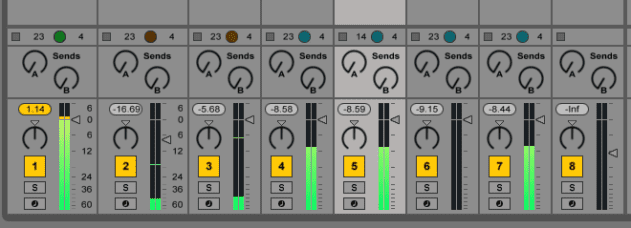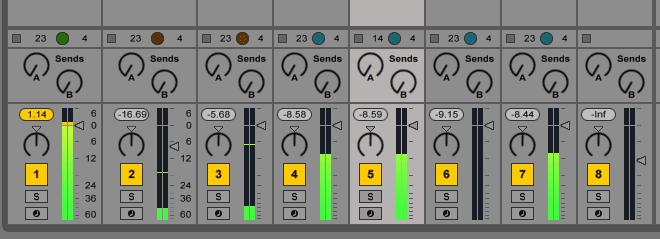Whether you produce entirely in the box or use a wealth of outboard gear, understanding levels is a must. From decibels to headroom, Bruce Aisher runs through the essentials.

Decibels, VU meters and bit depth might not be many people’s idea of fun, but no one promised everything about music production was going to be glamorous. Let’s be honest: there’s a reason so many producers’ eyes glaze over when this kind of subject comes up. No one starts producing because they’re excited by nerdy technical details with a light sprinkling of physics and mathematics.
But the truth is that there’s no need to overcomplicate the subject. A little knowledge is all you need to follow the fundamental rules of essential techniques such as gain staging, metering and setting recording levels. A basic understanding can help you get the most out of your plugins, get the best quality recordings when working with outboard gear and, most importantly, get a cleaner, better sound from your productions.
We’re not here to bore you to tears with a science lesson, so we’ve distilled the topic down to the essentials. Let’s take a (fairly) quick run through the details every producer should know about levels.
The decibel and its many guises
The first essential when it comes to understanding levels is to realise that ‘decibel’ has more than one meaning.
Like so many areas of recording and sound technology, the terminology we use when measuring audio signal levels in all their guises comes from the earliest days of the telephone, and in particular from the commercial research behemoth of Bell Labs in the USA (named after the engineer Alexander Graham Bell).
The decibel (one tenth of one bel, also name after the great man) is widely used in sound engineering as a relatively straightforward way of representing the ratio
of one signal’s level to another, but specific usages have quite different meanings in practical terms.
Values are measured in relation to a reference value, hence the reason we end up with a different types of decibel (dB) reading for a range of applications. For example:
dB SPL – for measuring sound pressure level (SPL), with 0dB theoretically equating to the quietest sound audible to the human ear. SPL can be measured in different ways, so dB SPL may also be measured by, for example, dBA (referring to a so-called ‘A-Weighted’ frequency response).
dBV – voltage measured relative to 1 volt.
dBu (sometimes labelled as dBVU) – voltage measured relative to 0.775 volts.
dBFS – decibels measured relative to full scale. Full scale (at 0dBFS) being the maximum number a particular digital system can represent.
It’s important to note that they’re not all the same, so it’s best to see them as self-contained descriptions of level for use in different situations.
In practice, there are countless cases where ‘decibels’ is used as a standalone term, with the specific type of measurement left unstated. In these cases, the reference point has to be inferred from the context. When talking about decibels in a DAW, for example, it’s assumed that we’re talking about dBFS since it’s a digital system.
Decibel scales are logarithmic
The next most important thing to understand is that decibels are logarithmic (as opposed to linear) measurements.
A logarithmic scale allows you to represent the relative size of a massive range of values without resorting to repeated use of huge numbers. It is also closer to the way humans perceive the intensity of sound and visual stimuli.
In the case of the decibel, it uses a ‘base 10 logarithm’ in relation to the power ratio of two quantities. In essence this means that each 10dB increase leads to a ten-fold increase in the relative power. For example:
10dB increase = 10 times the power
20dB increase = 100 times the power
30dB increase = 1,000 times the power
…
100dB increase = 10,000,000,000 times the power
If we talk about amplitude rather than power (as is often the case when dealing with audio signals) the scaling is slightly altered, with each 20dB step being ten times bigger.
So if a mic amp has 60dB of gain at its maximum setting, it will be capable of multiplying the input voltage by 1,000.
Each 6dB increase leads to a doubling of amplitude. This conveniently relates to the intensity of a sound dropping by 6dB with each doubling in distance from the source (assuming a perfect acoustic space with zero reflections, etc).

06.43 AM
Came expecting Avicii.
Jah bless.
07.09 AM
Wow, seriously in-depth introduction and then some. Thanks Attack. Blowing away the ‘competition’ again.
09.22 AM
Thanks for this attack! great read, as always. this gs-thread probably adds some interesting details, too: https://www.gearslutz.com/board/so-much-gear-so-little-time/463010-reason-most-itb-mixes-don-t-sound-good-analog-mixes-restored.html (the title is a bit misleading, there is an in-depth explanation of the technical process behind the summing in a daw, check out the posts by paul frindle and skip burrows) I’m not sure about it, but shouldn’t the gain on the individual tracks be about -20 dB rms / -10 to -6 dB peak? i think 0 dbfs on each track can overload most plugins, as there are inter-sample-peaks and probably peaks that are caused by the processing in the plugin. would be interesting to hear your opinion about that. anyway, thanks again, and keep up the good work!
09.42 AM
Rob – thanks for the link. Yes, that kind of range seems about right for a safety-first approach.
01.09 AM
Good article guys! Here’s another great read about gain staging in a digital environment: http://www.masteringmastering.co.uk/gainstructure.html
11.37 AM
great article!
12.42 AM
I’m learning so much from this Guide, this is good stuff thanx man…!!!
02.41 PM
That mastering engineers article explains it all really well. I love Attack mag keep up the good work.
03.10 PM
Highly educational, thanks!